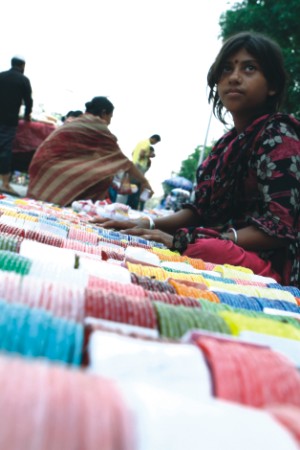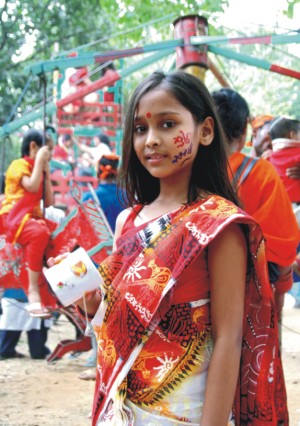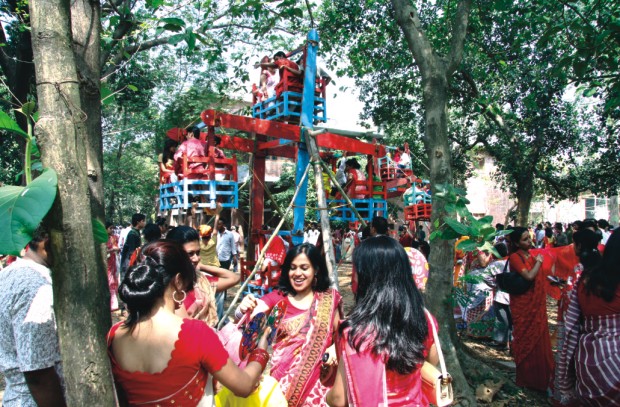Heritage
The Bengali Calendar lives on
Rifat Munim
 |
A girl displaying bangles for sale in front of the fine arts faculty on Pahela Baishakh.
Photo: Zahedul I Khan |
For Kamaluddin, a 55-year-old rickshaw puller in the Farmgate area, keeping track of the Gregorian calendar is quite a new experience. Ever since he migrated to Dhaka five years ago, he has had to keep himself informed either of the beginning or the end of a new Gregorian month, for it is around this time he has to pay the rent for his tiny, decrepit room in a slum. But ask him the date in the Bengali calendar, he would tell you with absolute accuracy. His quick response about the Bengali date would intrigue you to ask a second question about the calendar he follows, especially if it is exclusively a Bengali calendar or one that provides information about both. Before replying to this one, with as much indifference as possible, he takes a look around and gradually his eyes fix on a mango tree weighed down by thousands of small green mangoes. But having finished his seemingly mysterious act, the expression that his face takes on is that of a slight contempt, indicating clearly that he does not need a calendar whatsoever for being fully aware of the Bengali date. This conversation with Kamaluddin took place on last Thursday, April 7.
“Next Thursday would be Pahela Baishakh. Knowing this accurately is no big deal. Rather it's quite usual for us village people since everyone in rural areas grows up witnessing nature's changes in the form of various seasons with which our lives are closely connected,” he says in an accent that tells of his north Bengal origin. By then the contemptuous look has disappeared and an air of serenity has returned on his shrivelled face. He keeps reflecting, “Back in the village, our bond with seasons was very natural. A deep look at the nature's attributes is enough for us to understand what season it is or when it is changing from one season to another.” Such a remark only reminds one of one of Al Mahmud's poems titled 'Nirbhul Name' wherein the speaker declares that like a true farmer he also knows the secrets of nature; hearing the clouds rumble he also can predict when it will rain precisely; sniffing at a crop he can foretell when it will ripen. As the speaker in Mahmud's poem goes on citing other things as a proof of his oneness with the natural cycle of seasons, he resembles Kamaluddin all the more.
“With Boishakh setting in, farmers harvest one crop and plant another. I myself will leave for my village shortly, because this Boishakh we will sow the seeds of Athash and Heera (two local varieties of IRRI) which will be harvested with the beginning of Jaishtha,” he explains.
However, things for 70-year-old Khalilur Rahman are a little different. It has been more than three decades since he settled in Dhaka. Although he keeps switching from one profession to another, most of the time he is seen selling cheap items such as cigarettes, chocolate and water. After all these years of arid, urban existence he can now hardly relate himself to a Bengali calendar.
 |
Typical scenes of a Baishakhi fair with children rejoicing in a merry-go-round and grown-ups chatting. Photo: Zahedul I Khan |
“As a villager in a rural area of Tangail, we had to follow the Bengali calendar. But now all those are memories. The first thing that now bugs me towards the end of a month is the rent for my room in the Katabon slum,” he says defending himself. “Above all, no one in the city bothers about the Bengali months. So if you live in Dhaka, you'll have to cope with that.”
The cultural metamorphosis seems inevitable for those who have lost all connection with their ancestral homestead in villages. On the other hand, for those, who like Kamaluddin were born and brought up in the village and are forced to oscillate between the city and the village for their living, the Bengali calendar is still very much a familiar phenomenon. But for those who live in villages permanently, as both Kamaluddin and Khalilur Rahman observe, the Bengali month is an integral part of their quotidian existence. Yet, what Kamaluddin reveals is quite illuminating.
“Festivals related to Baishakh are on the wane in my village. Neither Baishakhi fairs nor Halkhatas (a feast on the occasion of opening new accounts in businesses) are arranged these days,” he says.
In the more than thousand-year-old Bengali culture, numerous cultural programmes, festivals and feasts are inseparably connected with the seasonal cycle. People irrespective of their religion and gender take part in these carnivals. The most colourful among these festivals is held on the Pahela Baishakh. All dues are cleared up on the last day of Chaitra and the homesteads are cleaned. In the household, the celebration begins with traditional pithas and local foods. Outside, it is celebrated with Baishakhi mela and Halkhata. The former includes exhibiting and selling of various agricultural products, traditional handicrafts, toys, cosmetics, various kinds of food and sweets, and entertainments such as jatra, pala gan, kabigan, jarigan, gambhira gan and gazir gan; and the latter is the opening of a new business account whereby landlords and businessmen invite their tenants and customers to renew business. However, the festivities related to Baishakh now have put on a new look, shifting from the village to the heart of the capital.
A handful of literary and cultural activists associated with Chhayanaut initiated the festival in this fashion at the Ramna Batamul to protest at the then Pakistani government's suppressive decision to ban Tagore songs immediately after the Indo-Pak war in 1965. It has since come to represent the ever-existent non-communal spirit so steeped in the Bengali culture. But whenever it comes to the Bengali calendar and the lifestyle attached to it, how far are the Dhakaites familiar with all that?
Mou Priyotoshi Sharna, a third year student of Philosophy at Dhaka University, fumble for words when asked about the new Bengali year we have stepped into. After beating about the bush for some time, all she could gather is the year 1417 which we left behind.

Photo: Zahedul I Khan
“Honestly speaking, I do not know much about the Bengali months since I can get on well with my life without any knowledge of this,” confesses Sharna. Most of her friends at the university echo her opinion when asked the same question.
Dr. Rafiqullah Khan, professor of Bengali Literature at DU, thinks that even though Baishakh festivals have waned in villages, existence of the Bengali calendar has not.
“Because of the agrarian economy in rural Bangladesh, the social, cultural and the economic life of villagers is so intertwined with the Bengali calendar that they cannot do without it,” he says. “We urbanites may well do without it and find it useful only around Baishakh and Phalgun.”
However, he is firmly against the idea that the biggest cultural festival at the DU area both in terms of enthusiasm and mass gathering is pretentious.
“It is true city folks are used to a way of life that alienates them from whatever is indigenous. But then, think of the massive gathering of Dhakaites on that day. You won't find so many people even in the biggest religious festival, be it Puja or Eid. So there is no gainsaying the fact that it now represents the biggest cultural festival of the country fostering the centuries-old non-communal spirit in people,” he opines.
But he points out another problem which he thinks may gradually create a gulf between the peoples of the two Bengals. At present, Pahela Baishakh is celebrated on two different days in the two Bengals. Bangladesh observes it on April 14 while West Bengal on April 15.
“I believe that uniformity of a Bengali calendar is what can effectively bridge the entire gap created so far by many political upheavals. So I think intellectuals, scientista and government authorities from both the countries should sit immediately and come to a unanimous decision as to the uniformity of the almanac and as such the Bengali calendar,” he says.
Auparesh Kumar Banerjee, director of Bangla Academy, and who is also in charge of the department that supervises the publication and reformation of Bengali calendar, affirms that our calendar is more scientific than Kolkata's.
“Both the Bengals follow the reformations suggested by the pre-eminent Bengali scientist Dr Meghnadh Saha, still there are some differences. And Bangla Academy thinks that ours is more scientific,” says Banerjee. Asked about the possibility of an expanding cultural gap and hence a unanimous decision, he says, “If a meeting is arranged, we can sit and talk. But for a unanimous decision to make, I think, both sides should show flexibility.”
Mass people do not know so much about the debates related to the exact date in the calendar, nor do they need to. But considering the village people's oneness with the Bengali months, and the spontaneous as well as ever-increasing gathering of the Dhakaites at DU area on the day, one can positively predict like the speaker in Mahmud's poem that the Bengali calendar lives on and will continue to do so even in the face of the most insidious sort of cultural transformation.
|
